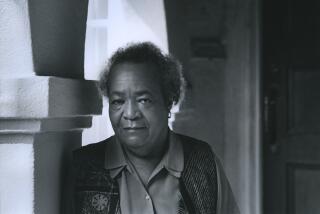Natalie de Blois dies at 92; pioneering female architect
- Share via
Natalie de Blois’ pioneering path through the male-dominated world of architecture was laden with sexist barriers.
Despite her status as an associate partner at the Chicago powerhouse Skidmore, Owings & Merrill in the 1960s, de Blois invariably was left behind when meetings broke up.
“Natalie used to tell stories abut how they would break for lunch and then the male partners would take the clients to an all-male club and she couldn’t attend. She’d have to go out and have a sandwich,” Chicago architect Carol Ross Barney recalled this week.
De Blois, who played a leading role in the creation of such modernist icons as the former Pepsi-Cola headquarters on New York’s Park Avenue, died July 22 in Chicago. She was 92.
The cause of death was cancer, her son Nicholas said.
In his 1973 autobiography, Nathaniel Owings, one of the founders of Skidmore, Owings & Merrill, stated explicitly that de Blois deserved credit for projects that typically went to senior male partners.
“Her mind and hands,” Owings wrote, “worked marvels in design — and only she and God would ever know just how many great solutions, with the imprimatur of one of the male heroes of SOM, owed much more to her than was attributed by either SOM or the client.”
He described her this way: “Long, lean, quizzical, she seemed fit to handle all comers. Handsome, her dark, straight eyes invited no nonsense.”
Born in Paterson, N.J., in 1921, de Blois studied architecture at Columbia University and after graduating in 1944 was quickly hired by a New York firm that paid her $25 a week. But she lost that job, she recalled in a 2004 interview with the late architectural historian Detlef Mertins, after she rebuffed the affections of one of the firm’s architects and he told the boss “that he just couldn’t work with me there.”
She was promptly let go and sent one floor downstairs to the offices of the then-fledgling firm of Skidmore, Owings & Merrill, she told Mertins in an article that appeared in the SOM Journal.
“Best thing that ever happened to us,” Richard Tomlinson, the managing partner of the firm’s Chicago office, said this week.
Rising to the level of senior designer, de Blois worked with SOM design partner Gordon Bunshaft on the 1960 Pepsi building, which was praised by critics for its gem-like, seemingly levitating exterior walls of gray-green glass and aluminum. The building was declared a New York City landmark in 1995.
During her stint at the firm’s New York office, de Blois also helped shape such noteworthy modernist buildings as New York’s Lever House and the Connecticut General Life Insurance headquarters outside Hartford. And she had to deal with requests like one she said Bunshaft made to her while they were preparing for a meeting about New York’s Kennedy International Airport.
“Gordon looked at me and he said, ‘You can’t come to the meeting unless you go home first and change your clothes. I don’t like green,’ ” she recalled. “So I went home and changed my clothes.”
In the early 1960s, de Blois, who was divorced, moved to Chicago so her children could be closer to their father and stepmother.
At the Chicago office of Skidmore, Owings & Merrill, she worked under partner Bruce Graham — who would go on to design the Sears (now Willis) Tower and the John Hancock Center — on the structurally expressive Equitable Building at 401 N. Michigan Ave. She was promoted to associate partner in 1964.
In the early 1970s, de Blois was a founding member of Chicago Women in Architecture. The nonprofit group, dedicated to advancing the status of women in architecture, still exists. Its members drew inspiration from de Blois as she simultaneously raised four children and forged a career in architecture.
“At least I had someone as a role model,” Barney said. “There weren’t any others at that point.”
After leaving Skidmore, Owings & Merrill in 1974, de Blois worked at a Houston architectural firm and taught architecture at the University of Texas. At the time of her death, she lived in the Mies van der Rohe-designed Promontory Apartments in Hyde Park. She also lived in the south of France.
Besides Nicholas, she is survived by three other sons, Fran, Robert and Patrick, and a sister, Elizabeth Parris.
Twitter @BlairKamin
More to Read
Start your day right
Sign up for Essential California for the L.A. Times biggest news, features and recommendations in your inbox six days a week.
You may occasionally receive promotional content from the Los Angeles Times.






